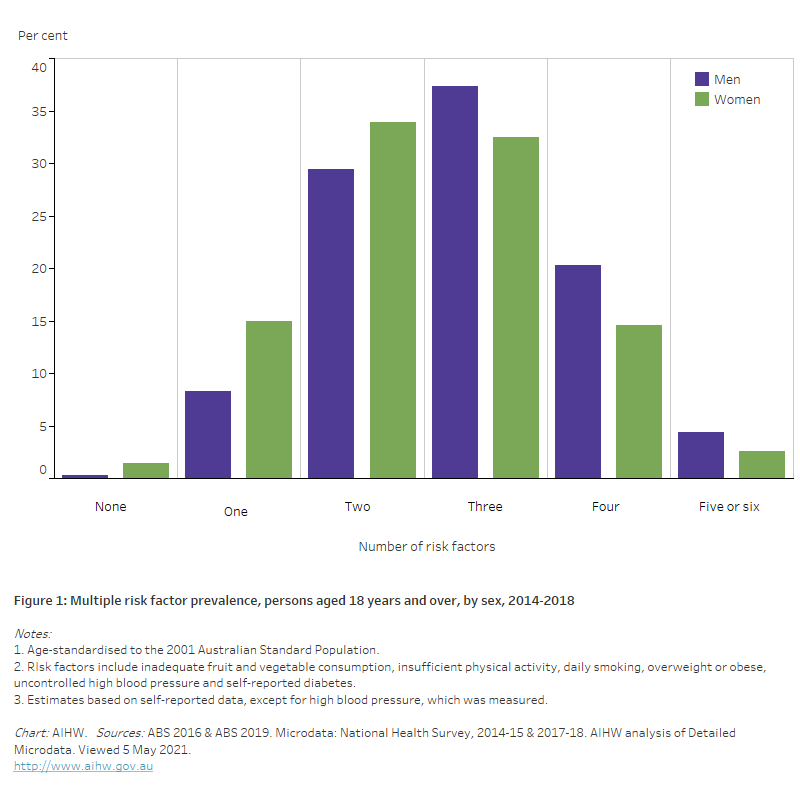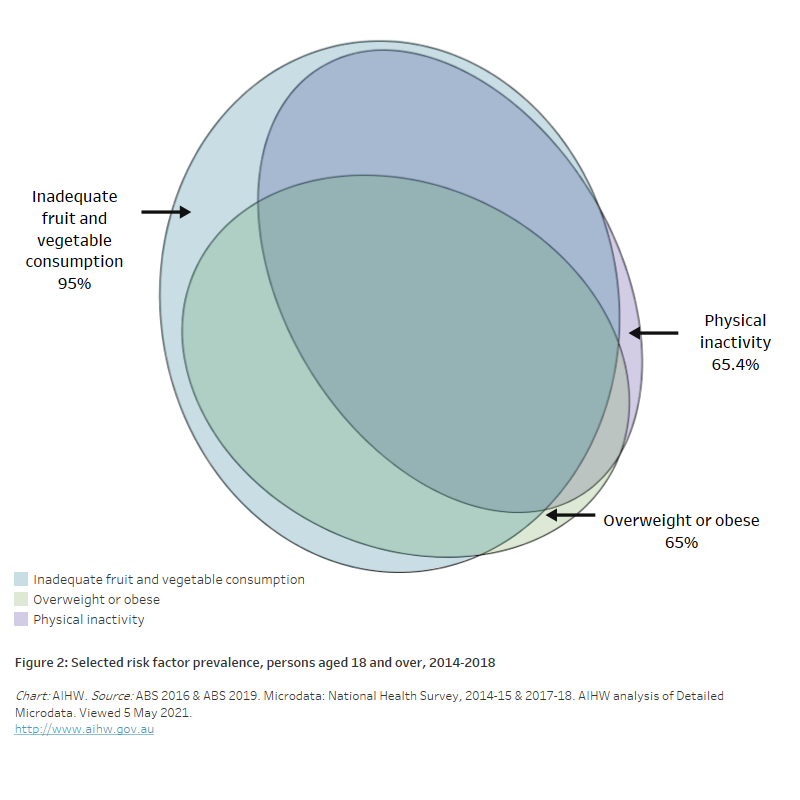Multiple risk factors
Multiple risk factors have an interactive or cumulative effect on disease risk. The more risk factors a person has, and the greater the degree of each risk factor, the higher the risk of developing cardiovascular disease, including coronary heart disease, stroke or angina (AIHW 2005, Poulter 1999).
The increased risk of cardiovascular disease associated with multiple risk factors presents an increased risk of poorer health outcomes, reduced life expectancy and death (Li et al. 2018, Berry et al. 2012).
One recent study reported that men and women aged 50 who have a favourable lifestyle –overweight but not obese, light / moderate drinker, non-smoker and participating in vigorous physical activity—lived between 7 and 15 years longer than those with an unfavourable lifestyle (O’Doherty et al. 2016). Interventions that reduce levels of multiple risk factors have been shown to help prevent cardiovascular disease in high-risk groups (Ebrahim & Davey Smith 2000).
Based on pooled data from the ABS 2014–15 and 2017–18 National Health Surveys:
- almost all Australian adults (99%) had at least 1 of 6 selected cardiovascular risk factors—either inadequate fruit and vegetable consumption, insufficient physical activity, daily smoking, overweight or obese, uncontrolled high blood pressure or self-reported diabetes (AIHW analysis of ABS 2016 and ABS 2019)
- 1 in 3 adults (31%) had 2 of these risk factors in combination, while 57% had 3 or more risk factors in combination, including 3.6% who had 5 or 6 risk factors (Figure 1)
- men (62%) were more likely than women (50%) to have 3 or more risk factors in combination.
Figure 1: Multiple risk factor prevalence, persons aged 18 years and over, by sex, 2014–2018
The bar chart shows the distribution of number of risk factors in 2014–18, with men (62%) more likely than women (50%) to have high levels of 3 or more risk factors.

Multiple behavioural risk factors
Many adults who are overweight or obese are also insufficiently active and/or have inadequate fruit and vegetable consumption. Based on pooled data from the ABS 2014–15 and 2017–18 National Health Surveys:
- an estimated 7.7 million adults (42%) had all 3 of these risk factors (men 47%, women 37%) (Figure 2) – rising to 50% among adults who had heart, stroke and vascular disease.
Figure 2: Selected risk factor prevalence, persons aged 18 and over, 2014–2018
The Venn diagram shows the overlapping proportion of adults who were overweight/obese, insufficiently active or had inadequate fruit and vegetable consumption in 2014–18. An estimated 42% had all 3 risk factors.

Multiple biomedical risk factors
Based on pooled data from the ABS 2014–15 and 2017–18 National Health Surveys:
- an estimated 2.9 million adults (16%) were overweight or obese, and had uncontrolled high blood pressure (men 18%, women 13%)
- 2.1% of adults were overweight or obese, had uncontrolled blood pressure and had diabetes (men 2.4%, women 1.8%) – rising to 4.8% among adults who had heart, stroke and vascular disease.
Blood lipid levels were not measured in the 2014–15 or 2017–18 National Health Surveys. An estimated 1-in-4 (25%) adult respondents to the 2011–12 Australian Health Survey had both high blood pressure and abnormal blood lipids. This includes people with measured high blood pressure and abnormal blood lipids, and those who took medication to control these conditions. The proportion increased with age, from 4.3% in people aged 18–34 to 65% in people aged 75 and over (AIHW analysis of ABS 2014; AIHW 2015).
ABS 2014. Microdata: Australian Health Survey, core content—risk factors and selected health conditions, 2011–12. AIHW analysis of Expanded Confidentialised Unit Record File. Viewed 25 March 2015.
ABS 2016. Microdata: National Health Survey, 2014–15. AIHW analysis of Detailed Microdata. Viewed 5 May 2021.
ABS 2019. Microdata: National Health Survey, 2017–18. AIHW analysis of Detailed Microdata. Viewed 5 May 2021.
AIHW 2005. Living dangerously: Australians with multiple risk factors for cardiovascular disease. Cat. No. AUS 57. Canberra: AIHW.
AIHW 2015. Cardiovascular disease, diabetes and chronic kidney disease—Australian facts: Risk factors. Cat. no. CDK 4. Canberra: AIHW.
Berry JD, Dyer A, Cai X, Garside DB, Ning H, Thomas A et al. 2012. Lifetime risks of cardiovascular disease. New England Journal of Medicine 366: 321–9.
Ebrahim S, Davey Smith G 2000. Multiple risk factor interventions for primary prevention of coronary heart disease. Cochrane Database Syst Rev. 2000;(2):CD001561
Li Y, Pan A, Wang DD, Liu X, Dhana K, Franco OH et al. 2018. Impact of healthy lifestyle factors on life expectancies in the US population. Circulation 138: 345–55.
O’Doherty MG, Cairns K, O’Neill V, Lamrock F, Jorgensen T, Brenner H et al. 2016. Effect of major lifestyle risk factors, independent and jointly, on life expectancy with and without cardiovascular disease: results from the Consortium on Health and Ageing Network of Cohorts in Europe and the United States (CHANCES). European Journal of Epidemiology 31: 455–68.
Poulter N 1999. Coronary heart disease is a multifactorial disease. American Journal of Hypertension 12:92S–95S.


